
This page gives background information and a summary of the meaning of our discovery of gamma-ray flares from the Crab Nebula ("Discovery of Powerful Gamma-Ray Flares from the Crab Nebula", Tavani et al. 2011, Science; paper here). Press and news links are at the bottom. Please email me (heinke (at) ualberta [dot] ca), or any of my collaborators with additional questions.

The AGILE gamma-ray telescope (Italian Space Agency, ASI).
This discovery was made by the AGILE gamma-ray observatory, an Italian satellite that measures gamma-rays, the highest-energy kind of light, produced by the most energetic sources in the sky. Gamma-rays are electromagnetic radiation, just like visible light, except that gamma-rays are higher energy (and thus shorter wavelength). Gamma-rays are blocked by the Earth's atmosphere, so to observe them we use satellites like ASI's AGILE telescope.
Astronomers have observed the remains of numerous supernovae, or exploding stars, using optical telescopes, as well as X-ray and radio telescopes. Supernovae are the deaths of massive stars, more than 8 times more massive than our sun. During the supernova, the core (about 1.4 times the mass of our sun) collapses into a tiny stellar remnant, a neutron star, while the rest of the star is blown out into space. Neutron stars are tiny, incredibly dense remnants of dead stars, compressing as much mass as our Sun into a star the size of a city. The explosion is as bright as an entire galaxy, 100 billion stars. Supernova explosions produce most of the elements we see in the universe (e.g. iron, gold, sodium, aluminum, uranium); without supernovae spreading these elements throughout the galaxy for later generations of forming stars, it would be difficult to produce planets like Earth or have life.
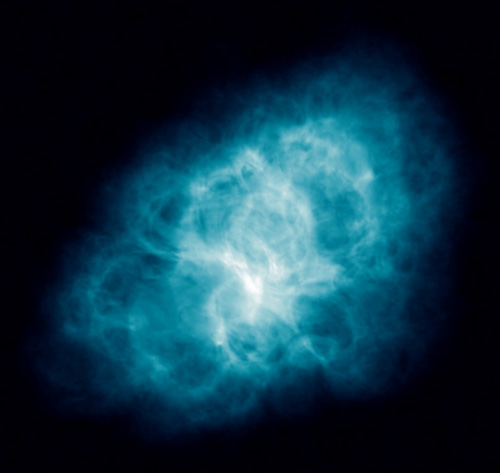
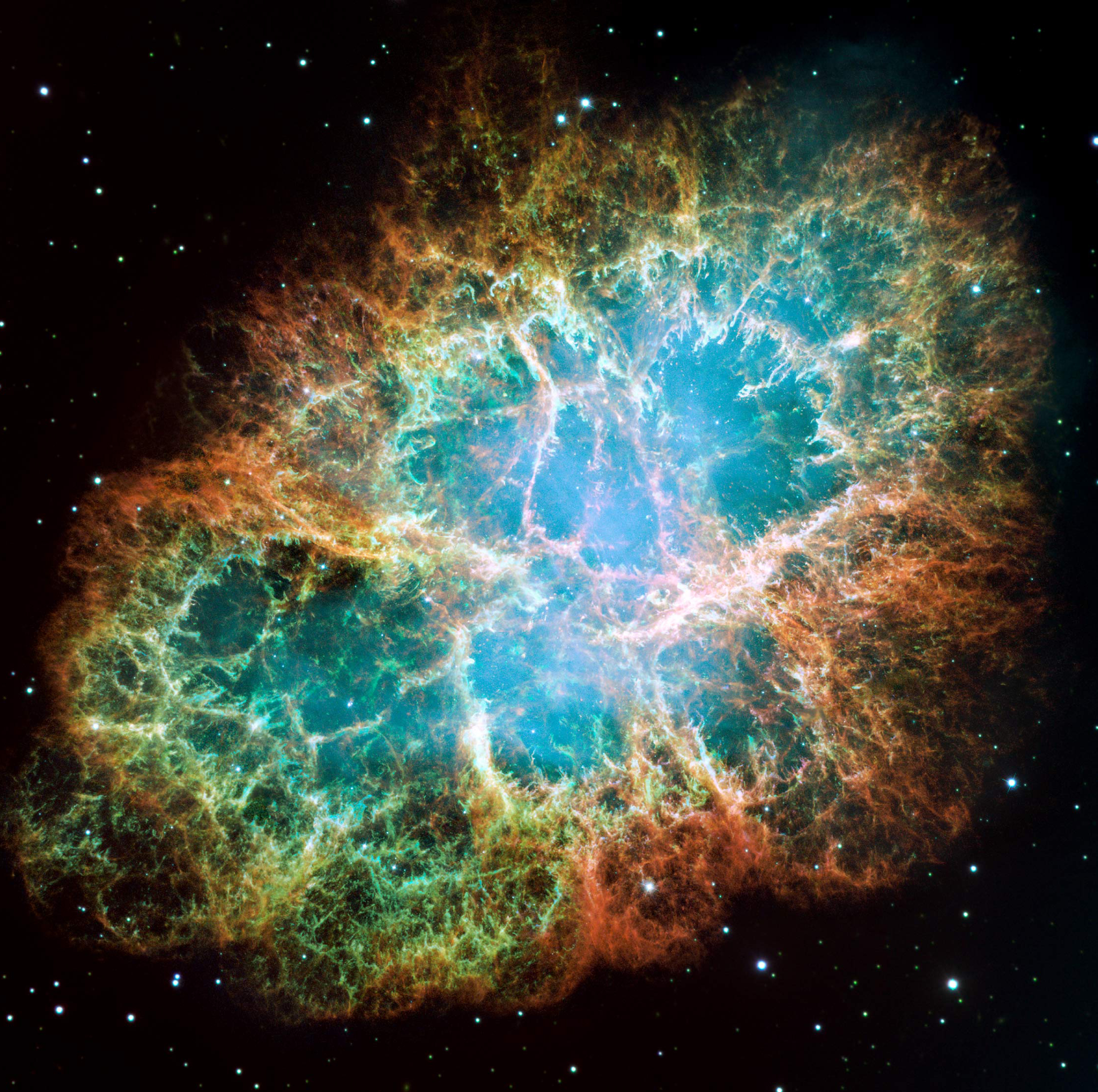
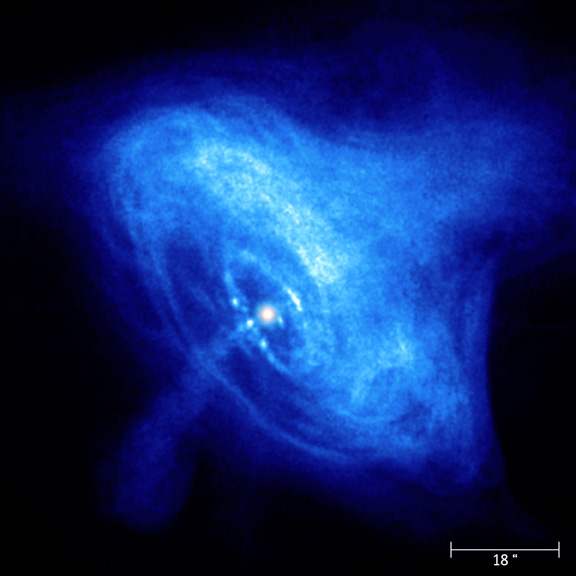
Crab Nebula supernova remnant: left, radio (VLA, NRAO); middle, optical (HST, NASA/ESA); right, X-ray (Chandra, NASA).
Above are images of the famous Crab Nebula supernova remnant seen in radio (left, Very Large Array), visible light (middle, Hubble Space Telescope), and X-rays (right, Chandra X-ray Observatory). (So far, we can't make as nice a picture in gamma-rays.) The Crab Nebula's neutron star is a radio pulsar, a rapidly spinning neutron star with a powerful magnetic fields. Charged particles (electrons, positrons, protons) are accelerated by those fields to enormous energy, generating emission near the pulsar's magnetic poles which is seen on Earth as pulsations. Thousands of pulsars have been detected by radio pulsations, while the most powerful pulsars such as the Crab can also be detected through pulsations in visible, X-ray, and gamma-ray light.
This highly magnetized plasma of high-energy particles (called a pulsar wind) flies off into the space around the pulsar. Eventually the plasma collides with the interstellar medium, producing a shock wave. This shock wave, and other complexities of the flow, set up a strong, complex magnetic field in this space around the pulsar. Charged particles moving through a magnetic field are forced to bend their paths, and emit energy as they turn--this is "synchrotron" radiation, and the region of space where these particles can be seen emitting is called the pulsar wind nebula. Depending on how energetically the particles are accelerated, the pulsar wind nebula may be seen in radio waves, visible light, X-rays, and even gamma-rays (the more energetic the particle, the higher the energy of the radiation it emits). Most of the emission we see from the Crab Nebula (the radio, X-ray, and gamma-ray emission, and the blue optical light) is this synchrotron radiation from high-energy particles.
Since the neutron star is continuously spinning and accelerating particles, and the particles are moving smoothly out into space, we astronomers have assumed that this emission is steady, and indeed it has seemed to be steady. We have relied on this assumption so much that we use the Crab as our standard calibration source for most X-ray and gamma-ray satellites, and use the Crab's emission as a reference unit (so we speak of a source's brightness in milliCrabs, for instance).
But now our AGILE team has discovered flaring in the gamma-rays from the Crab Nebula (confirmed by NASA's Fermi Gamma-ray Space Telescope, which is simultaneously publishing their result in Science). The AGILE team first noticed gamma-ray flaring from the Crab Nebula in October, 2007, but assumed it was a problem with the recently-launched satellite. When they saw another flare for four days in September 2010, they realized that this was a real change in the Crab Nebula, not an instrumental effect, and sent an instant notice to astronomers worldwide, followed the next day by the Fermi team confirming the result. I quickly obtained and analyzed X-ray observations (using NASA's orbiting Swift X-ray Observatory) to rule out the possibility of a background quasar causing the gamma-ray flare, and sent an instant notice about this result. I was then invited to join the AGILE team in follow-up analysis and the writing of the current paper. We took detailed images of the Crab Nebula with high-resolution X-ray (Chandra X-ray Observatory) and visible-light (Hubble Space Telescope) telescopes, identifying a brighter spot in the Crab Nebula that may be the location of the gamma-ray flare.
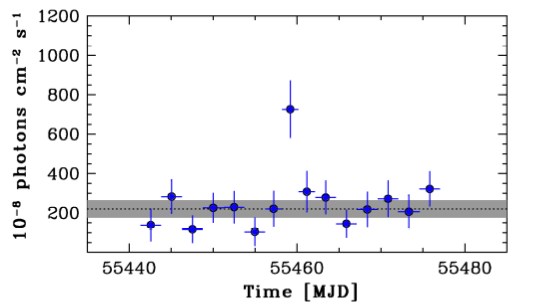
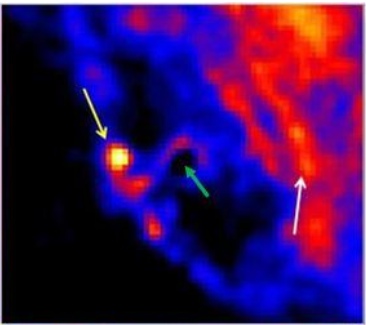
Left: History of the gamma-ray flux from the Crab Nebula detected with AGILE in September 2010. Bins are 2-2.5 days long. From Tavani et al. (2011). Right: Chandra X-ray image of the central portion of the Crab Nebula, showing the brightened spot (marked with yellow arrow, left), the position of the pulsar (marked with green arrow--the pulsar is so bright that its photons couldn't be recorded), and another brightened "wisp" (white arrow). From Tavani et al. (2011).
What caused the gamma-ray flare? The gamma-ray flare must have been produced by particles (electrons and positrons) being accelerated to extremely high energies, of ~1000 Tera-electron volts--100 times higher energy than the Large Hadron Collider can achieve! These extremely high-energy particles lose energy rapidly through synchrotron radiation, explaining the short lifetime of the gamma-ray flare (though the same particles, now at lower energy, can produce the X-ray and visible emission we see after the flare). We don't, however, understand why some particles were accelerated to such high energies. Perhaps the pulsar changed how it accelerates particles (though this seems unlikely, since the pulsar emission itself didn't change). Perhaps the flow of the pulsar wind bunched up, causing particles to be re-accelerated at the "bunching" to high energies. Whatever the cause, this process is among the most efficient particle accelerators in the universe. Many astronomers are studying this result to try to explain what is going on.
Links to releases and stories will be added below as they become available.
News stories:
Discovery News (by my colleague Nicole Gugliucci)
U of Alberta ExpressNews (focusing on my involvement)
Space.com, reprinted by MSNBC, Christian Science Monitor, etc.
Science News, reprinted in Wired
Stanford (Fermi) press release
New Scientist
Universe Today
Ars Technica
Space Daily
Epoch Times
International Business Times (ANI)